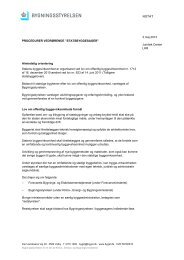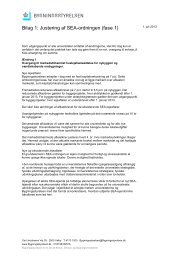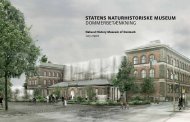Campus og studiemiljø - Bygningsstyrelsen
Campus og studiemiljø - Bygningsstyrelsen
Campus og studiemiljø - Bygningsstyrelsen
You also want an ePaper? Increase the reach of your titles
YUMPU automatically turns print PDFs into web optimized ePapers that Google loves.
“ på campus finder<br />
man fremragende<br />
arkitektur samt by- <strong>og</strong><br />
landskabsdesign. det er<br />
her, den amerikanske<br />
storbys fremtid <strong>og</strong><br />
ideal realiseres / on<br />
campus, brilliant urban<br />
and landscape design<br />
and architecture can be<br />
found. this is where the<br />
future and the ideal of<br />
the american city are<br />
realised<br />
en typisk forskel mellem den amerikanske<br />
<strong>og</strong> det europæiske campus er, at det<br />
amerikanske er vokset gradvist i store <strong>og</strong><br />
mellemstore by-lignende bygningsstrukturer,<br />
mens vi i europa oftest har bygget store<br />
undervisningsanlæg på én gang. Her ses<br />
universitat autònoma de Barcelona <strong>og</strong><br />
princeton universitet i samme skala. / one<br />
typical difference between the american<br />
and the european campus is that the<br />
american has grown step by step in large<br />
and medium-sized urban-like building<br />
structures, whilst in europe, we have more<br />
often built large teaching complexes in<br />
one go. Here, universitat autònoma de<br />
Barcelona and princeton university shown<br />
on the same scale.<br />
tre perspektiver: internationalt / tHree perspeCtives: international<br />
American college system. Living t<strong>og</strong>ether<br />
and socialising while taking responsibility<br />
and learning thus form the undergrad curriculum.<br />
The on-campus housing forms the special<br />
character and the 24 hour-liveliness of the<br />
American campus – a quality that the European<br />
campus will never be able to achieve<br />
on university locations.<br />
the european campus – innovation<br />
starts with trace tracking<br />
Harvard may be brilliant and attractive.<br />
However, even though it is more difficult<br />
to spot, the European ‘campus’ exists, is<br />
alive and is worth further development! It<br />
is a space intertwined with the surrounding<br />
city, neighbourhoods and their culture<br />
and infrastructure. In university cities like<br />
Tübingen or Florence, the entire city takes<br />
on a ‘light’ university lifestyle and in Munich<br />
and Barcelona, the university shapes<br />
residential neighbourhoods, a bar scene<br />
and cultural activities, and creates an active<br />
street life.<br />
Unfortunately, public opinion did not rec<strong>og</strong>nise<br />
this ‘secret’ until it was endangered.<br />
The University of Frankfurt planned to<br />
create the ‘Harvard of Europe’ by moving<br />
from its embedded location to three remote<br />
campus areas. When one visits these newly<br />
built places on a Saturday it is notable:<br />
closed gates, empty, guarded. This is not<br />
a campus but an empty hull, lacking the<br />
proper history and background. Now that<br />
the students have moved away from the<br />
old locations, action groups have formed to<br />
‘save’ the university character of the neighbourhoods.<br />
Harvard as a place does not work in Europe.<br />
It rather endangers the variety, the cultural<br />
qualities and the special charm of the European<br />
university campus.<br />
To further develop this European campus<br />
we recommend three main points of action:<br />
1. Description of the local particularities<br />
of the university and its surrounding city,<br />
promotion of its (often times hidden) qualities,<br />
thus creating an image.<br />
2. Analysis of all the various locations<br />
belonging to the university, as well as nonuniversity<br />
locations that clearly contribute<br />
to the university experience, optimising<br />
their infrastructure and improvement of<br />
their appearance/functionality.<br />
3. The ‘zip’ strategy: intertwining city and<br />
university with public spaces, transportation,<br />
bicycle paths, continuous signs and<br />
landmarks as well as through shared institutions,<br />
culture and activities.<br />
Above all, it is important to agree on the<br />
general rule: The space of a university is<br />
its campus. This space by far exceeds the<br />
sum of the locations of the university and<br />
is only functional as a whole. Where, as is<br />
the case with most European universities,<br />
university and city are complexly intertwined<br />
it becomes challenging to describe<br />
the campus. The European university is not<br />
an island in the city; its space overlaps large<br />
city neighbourhoods. <strong>Campus</strong> development<br />
thus becomes a matter of collaboration<br />
between university and city developers<br />
and planners. This collaboration between<br />
university and city planners is urgent and<br />
essential and mutually beneficial for the development<br />
of both the European university<br />
and the European city!<br />
NOTES<br />
1 This definition of ‘campus’ as ‘space’ is based on<br />
the relational understanding of space described by<br />
Prof. Martina Löw. She understands space as the relational<br />
order of social goods and people in a certain<br />
place. This perception of space connects the structuring,<br />
static and ordering function of space with its<br />
genesis and permanent change (Löw 2001).<br />
21

















